中国气象学会主办。
文章信息
- 张其林, 张源源, 李东帅, 樊艳峰, 高金阁 . 2013.
- ZHANG Qilin, ZHANG Yuanyuan, LI Dongshuai, FAN Yanfeng, GAO Jinge . 2013.
- 地形地表的不规则起伏对雷电电磁场传输的影响
- Effect of irregular terrain on propagation of lightning electromagnetic field
- 气象学报, (2): 357-365
- Acta Meteorologica Sinica, (2): 357-365.
- http://dx.doi.org/10.11676/qxxb2013.020
-
文章历史
- 收稿日期:2012-03-30
- 改回日期:2012-10-16
2. 南京信息工程大学大气物理学院, 南京, 210044
2. College of Atmospheric Physics, Nanjing University of Information Science and Technology, Nanjing 210044, China
地闪回击电磁辐射与传输是雷电物理、雷电探测、电力输电线耦合过电压计算、以及雷电电磁兼容等方面研究的重点(Master et al,1984; Cooray et al,1986; Rubinstein et al,1989; Zhang et al,2009,2011a,2001b,2012a,2012b)。由于地面电导率有限,当雷电电磁场沿地表传播时,高频分量快速衰减,引起时域电磁场脉冲峰值额外减小、波形上升时间额外增大,从而对时差法雷电定位、雷电流强度反演等方面产生影响(Rubinstein et al,1996; Cooray et al,2000; Cooray,2008,2009; Delfino et al,2008a,2008b; Shoory et al,2010)。因此,20世纪80年代初期,为了研究雷电电磁频谱,通常利用海面传播路径进行测量,因为海水的电导率较大(4 S/m),高频电磁场衰减相对较小。Weidman等(1980,1981)、Willett等(1990)观测表明,当观测点距离海岸线几十至几百米时,在海洋雷暴地闪回击产生的电磁波谱中,超过1 MHz的高频分量按照频率平方的倒数迅速衰减,超过20 MHz的则几乎观测不到。Ming 等(1994)、Zhang等(2012a,2012b)模拟研究了粗糙海面对雷电电磁场传输的影响,指出当频率高于10 MHz时,粗糙海面引起的衰减是不容忽视的。
和粗糙海面相比,陆地的电导率更小,地形地表的不规则起伏也更加明显。尽管有许多对雷电电磁场沿地表传播的研究,但都是将地表假定为光滑地表,这与实际情况是明显不符的(郄秀书等2007;Qie et al,2009;杨静等,2008;Zhang et al,2009,2011a,2011b; Rubinstein et al,1996; Cooray et al,2000;Cooray,2008,2009; Shoory et al,2010)。中国地域广阔,不同地区地形地貌千差万别,既不是纯周期的,也不是完全随机的,采用周期函数和随机函数的数学模型,如正弦函数和高斯随机分布函数均不能反映粗糙地表面的真实情况(郭立新等,2000,2010;Jaggard et al,1990)。从统计意义上讲,在一定的标度之间,一般的地形地貌都存在自相似性或仿射性,并具有分形的特点(赵冬华等,2005;张捷等,1994;艾南山等,1999)。Mandbrot(1982)的分形学从诞生之日起就打上了地貌学的烙印(艾南山等,1999)。分形几何的引入为自然粗糙结构提供了新工具,因为分形具有自相似性,可兼顾大范围有序和小范围无序的特点,因此,可用来描述确定的或随机的结构。利用分形理论对粗糙面进行模拟,可集周期函数和随机函数于一体。随着二维粗糙面程度的加大,分维数从2向3增大。
因此,为了深入讨论复杂地形地表对雷电电磁场传播的影响,本文采用分形模拟的粗糙地表,利用Barrick表面阻抗理论和Wait(1963a,1963b,1974)近似算法,分析研究粗糙地表对地闪回击电磁场传播的影响。研究结果对进一步提高地基雷电探测技术具有科学意义和实际参考价值,因为可能是由于复杂传播路径对雷电电磁场传播的影响,致使不同地区的雷电定位系统探测效率和精度等存在很大的区别。2 复杂地表情况下雷电电磁场近似算法
假定地面电导率无限大,闪电通道垂直于地面,地表任意一点处的垂直电场和水平磁场的时域表达式分别为(Thottappillil et al,1997,2001)
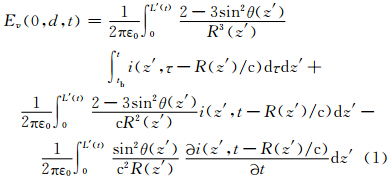

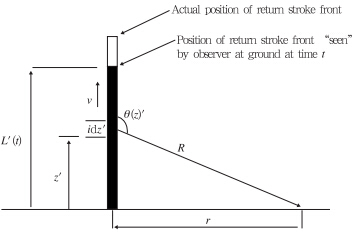 |
| 图 1 雷电回击过程示意图 Fig. 1 Geometry used in deriving the expressions for the lightning electromagnetic fields on the ground level generated by lightning return stroke |
当地面电导率有限时,距雷电通道水平距离d处的垂直电场和水平磁场分别为(Shoory et al,2011; Cooray et al,1994)





 ,erfc为余补误差函数,Z为归一化表面阻抗。因此,由式(1)—(7)可知,分析粗糙地表雷电电磁场传播的关键是其等效表面阻抗Δeff的计算。3 粗糙地表等效表面阻抗Δeff计算3.1 等效表面阻抗
,erfc为余补误差函数,Z为归一化表面阻抗。因此,由式(1)—(7)可知,分析粗糙地表雷电电磁场传播的关键是其等效表面阻抗Δeff的计算。3 粗糙地表等效表面阻抗Δeff计算3.1 等效表面阻抗按照Barrick(1971a,1971b)等效表面阻抗理论,粗糙地表等效表面阻抗Δeff可表示为(Ming et al,1994)







其中,V(γ,η)是粗糙地表的高度谱密度函数。如果已知V(γ,η),根据式(8)—(14)可以计算粗糙地表的归一化等效表面阻抗Δeff。因此,下面首先介绍粗糙地表的高度谱密度函数V(γ,η)。3.2 粗糙地表模型
为了计算分形粗糙地表的有效表面阻抗Δeff,首先要解决平均高度谱密度V(γ,η)。本文采用蒙特卡罗方法模拟二维分形粗糙地表,其高度谱密度为(Falconer,1990)

 |
| 图 2 利用蒙特卡罗方法模拟的二维粗糙地表 (a.H=5 m,b.H=30 m) Fig. 2 Two-dimension fractal Brown motion fractal ground model simulated by using the method of Monte Carlo for a mean square height of(a)H=5 m,and (b)H=30 m |
为了分析不同程度的粗糙地表对其表面阻抗和衰减函数的影响,图 3分别给出了表面阻抗Δeff和衰减函数W(0,d,jω)的频域,其中,衰减函数的幅值用dB来表示,实线表示地面电导率σ=0.1 S/m,相对电容率εr=10,虚线表示地面电导率σ=0.001 S/m,相对电容率εr=10。曲线1表示光滑地表,曲线2和3表示粗糙均方高分别为H等于5、30 m的粗糙地表。可以看出,当地表粗糙度在5 m以内时,其等效阻抗以及衰减因子和光滑地表几乎相同,但当粗糙度超过30 m时,粗糙地表引起的额外衰减非常明显。
 |
| 图 3 粗糙地表面的等效阻抗(a)及衰减函数(b) Fig. 3(a)Effective surface impedance and (b)amplitude of the attenuation function in decibel(i.e.,20lg|W(0,d,jω)|)for a distance of 10 km on the finitely conducting ground level |
进一步分析相关长度L对衰减因子的影响(图 4)可知,当相关长度L超出几十米以后其影响可忽略。因此,在实际工作中,主要应该关注粗糙高度平方根对雷电电磁波传播的影响。
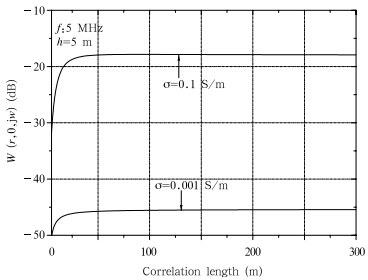 |
| 图 4 相关长度因子L对衰减因子的影响 Fig. 4 Effect of the correlation length factor L on the attenuation function |
假定地闪回击通道笔直且垂直于地面,回击电流从通道底部始发,沿通道以速度v=1.9×108 m/s向上传播。电流波形随高度的衰减满足电流线性衰减的传输线(MTLL)回击模型,假设回击通道为8 km。回击电流包含击穿电流和电晕电流两部分,击穿电流和电晕电流都采用Heidler(1985)指数表达式(16),具体参数如表 1所示(Rachidi et al,2001)。

 ,η2=
,η2= 。4.2 粗糙地表对地闪回击垂直和水平磁场分量的影响
。4.2 粗糙地表对地闪回击垂直和水平磁场分量的影响| I01(kA) | τ11(μs) | τ21(μs) | I02(kA) | τ12(μs) | τ22(μs) | |
| 首次回击 继后回击 | 28
1 0.7 | 1.8 0.25 | 95
2.5 | - 6.5 | -
2 | - 230 |
利用式(1)—(15),图 5给出了粗糙地表对首次回击和继后回击产生的垂直电场的影响(电导率σ=0.1 S/m,相对电容率εr=10)。曲线1对应电导率无限大的光滑地表(理想地表),曲线2对应有限电导率的光滑地表,曲线3和4对应于不同程度的粗糙地表(相关长度L=150 m,粗糙均方高分别为5和30 m)。可以看出,粗糙地表对继后回击电磁场的影响明显比首次回击大,首次回击波形上升沿时间略有影响,但峰值大小几乎不受影响。这是因为首次回击包含有更多的低频分量,频率越低,波长越长,粗糙地表的影响越小。对继后回击而言,由于高频分量的衰减,随着粗糙度和传播距离的增加,峰值明显减小,辐射场波形上升沿时间增大,即峰值到达时间滞后。继后回击电磁场传播100 km,均方高为30 m的粗糙地表引起波形上升沿时间额外增加约1.5 μs,电场峰值约额外减小12%(图 5d),其影响随着地面电导率的减小而增大,这可能是直接影响雷电定位系统探测精度的原因之一。目前,雷电定位系统就是利用探测到的地闪电磁场波形参量来进行地闪定位和放电参数的反演,回击电磁场波形上升沿时间的额外增大(峰值到达时间的滞后)引起时差定位的误差,而电场峰值的额外减小引起雷电流强度反演的误差。比如,在均方高为30 m的粗糙地表情况下,雷电电磁场传播100 km,由于粗糙地表引起的电磁场额外衰减约12%,
因此,根据Ep=vIp/(2πε0c2d)(v为回击速度,c为光速,d为传播距离,Ep为辐射电场峰值,Ip为雷电流强度)(Cooray et al,2000),反演的雷电流强度比实际结果也偏小12%。
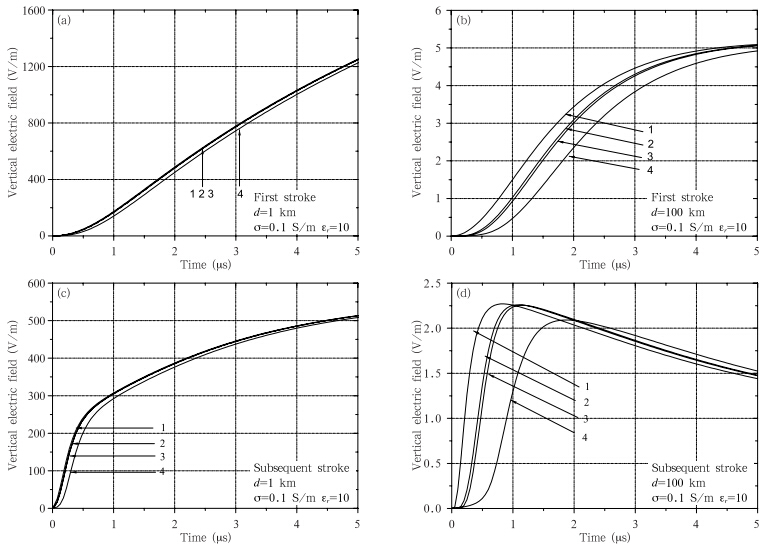 |
| 图 5 粗糙地表对首次回击(a、b)和继后回击(c、d)垂直电场的影响 Fig. 5 Effects of the rough ground on the vertical electric field in time domain produced by lightning first return strokes(a,b) and subsequent return strokes(c,d) |
此外,随着地面电导率的增大,粗糙度引起的额外衰减量增加。如电导率σ=0.1 S/m时,雷电电磁场沿均方高为30 m的粗糙地表传播100 km,场峰值衰减12%,而当电导率σ=0.001 S/m时,场峰值额外衰减8%。值得注意的是,雷暴天气往往下雨,土壤湿度增大,相应的土壤电导率增大,更应该考虑闪电定位系统测站周围的复杂地形对雷电定位系统探测精度和效率的影响。
不过,在距闪电通道1 km范围,无论是首次回击还是继后回击,粗糙地表的影响都很小。因为在1 km范围的近距离,地闪回击电磁场主要以低频的静电场为主(图 6)。
 |
| 图 6 距闪电通道1 km处的电场结构(ET表示总场、EQ表示静电场、EI表示感应场、ER表示辐射场) Fig. 6 Electric field components at distances of 1 km from the lightning channel(ET indicates the total field,EQ indicates the electrostatic term,EI indicates the induction term,and ER indicates the radiation term) |
为了进一步分析地表粗糙度对不同频段电磁波分量的影响,图 7给出了粗糙地表对首次和继后回击频域垂直电场传播的影响。选取的回击电磁波频率范围为几赫兹至10 MHz,计算的频率幅值采用dB表示方法(对幅值取常用对数后再乘以20),单位为V/(m·Hz)。可以看出,随着粗糙度的增加,约2 MHz以上电磁波的衰减明显增大,在同样地表粗糙度情况下,当地面电导率减小时,高频衰减更加明显。
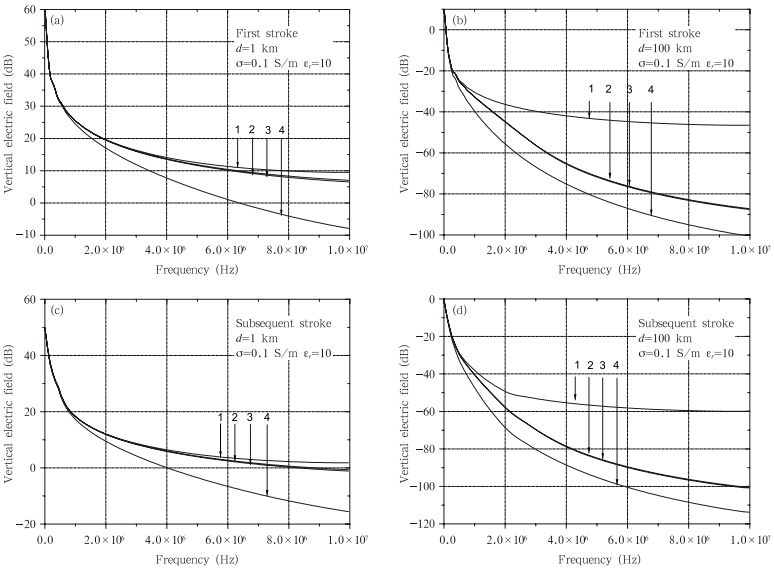 |
| 图 7 粗糙地表对首次回击(a、b)和继后回击(c、d)频域垂直电场的影响 Fig. 7 Effects of the rough ground on the vertical electric field in frequency domain produced by lightning first return strokes(a,b) and subsequent return strokes(c,d) |
图 8给出了粗糙地表对地闪回击水平磁场的影响。曲线1对应电导率无限大的光滑地表(理想地表),曲线2对应有限电导率的光滑地表(电导率σ=0.1 S/m,相对电容率εr=10),曲线3和4对应不同程度的粗糙地表(均方高分别为5、30 m、相关长度L=150 m)。可以看出,粗糙地表对水平磁场和垂直电场的影响是类似的。1 km以内的近距离,感应磁场占优势,粗糙地表对场峰值的影响可忽略;但随着距离的增大,由于高频分量的衰减,时域磁场波形的上升时间增大,峰值额外减小。因此,无论是利用测量的垂直电场进行雷电放电参数的反演,还是利用水平磁场进行反演,复杂地表的影响都不可忽视。
 |
| 图 8 粗糙地表对继后回击时域(a、b)及频域(c、d)水平磁场的影响 Fig. 8 Effects of the rough ground on the horizontal magnetic field in time domain(a,b) and frequency domain(c,d)produced by lightning subsequent return strokes |
分析了粗糙地表对雷电电磁场传播的影响,模拟结果表明,粗糙地表对地闪首次回击垂直电场的影响较小,但对继后回击存在明显的影响。随着粗糙度的增加,继后回击垂直电场峰值的衰减程度明显增加,且时域脉冲波形上升沿时间增长。如对继后回击而言,电磁场传播100 km,均方高为30 m的粗糙地表(电导率σ=0.1 S/m)引起波形上升沿时间额外增长约1.5 μs,电场峰值额外减小约12%,且其影响随着地面电导率的减小而加大。回击电磁场波形上升沿时间的额外增大(峰值到达时间的滞后)引起时差定位的误差,而电场峰值的额外减小引起雷电流强度反演的误差。因此,在实际工作中,应该考虑复杂地形地表对闪电定位系统探测精度和效率的可能影响。
本研究结果为地基雷电探测的场地误差分析等方面的工作提供了一种近似估算方法,其合理性已经被广泛接受(Wait,1956,1974,1998;Ming et al,1994; Zhang et al,2012a,2012b)。但这种算法的实验检验存在很大的难度,将来有望利用三维时域有限差分算法进行检验。
| 艾南山, 陈嵘, 李后强. 1999. 走向分形地貌学. 地理学与国土研究, 15(1): 48-53 |
| 郭立新, 吴振森. 2000. 二维导体粗糙面电磁散射的分形特征研究. 物理学报, 40(6): 1064-1069 |
| 郭立新, 王蕊, 吴振森等. 2010. 随机粗糙面散射的基本理论与方法. 北京: 科学出版社,300pp |
| 郄秀书, 张其林, 周筠珺等. 2007. 两次强雷暴系统中雷电的人工引发及其特征放电参量的测量与估算. 中国科学D辑(地球科学), 37(4): 564-572 |
| 杨静, 郄秀书, 王建国等. 2008. 雷电在水平导体中产生感应电压的观测及数值模拟研究. 物理学报, 57(3): 1968-1975 |
| 张捷, 包浩生. 1994. 分形理论及其在地貌学中的应用. 地理研究, 13(3): 105-110 |
| 赵冬华, 蔡志杰, 阮炯. 2005. 分形粗糙面分维数的反演. 中国科学, 35(4): 417-425 |
| Barrick D E. 1971a. Theory of HF and VHF propagation across the rough sea, 1, the effective surface impedence for a slightly rough highly conducting medium at grazing incidence. Radio Sci, 6(5): 517-526 |
| Barrick D E. 1971b. Theory of HF and VHF propagation across the rough sea, 2, Application to HF and VHF propagation above the sea. Radio Sci, 6(5): 527-533 |
| Cooray V, de La Rosa F. 1986. Shapes and amplitudes of the initial peaks of lightning-induced voltages in power lines over finitely conducting Earth: Theory and comparison with experiment. IEEE Trans Antennas Propag, 34(1): 88-92 |
| Cooray V, Ming Y. 1994. Propagation effects on the lightning-generated electromagnetic fields for homogeneous and mixed sea-land paths. J Geophys Res, 99(D5): 10641-10652, doi:10.1029/93JD03277 |
| Cooray V, Fernando M, Sorensen T. 2000. Propagation of lightning generated transient electromagnetic fields over finitely conducting ground. J Atmos Terres Phy, 62(7): 583-600 |
| Cooray V. 2008. On the accuracy of several approximate theories used in quantifying the propagation effects on lightning generated electromagnetic fields. IEEE Trans Antennas Propag, 56(7): 1960-1967 |
| Cooray V. 2009. Propagation effects due to finitely conducting ground on lightning-generated magnetic fields evaluated using Sommerfeld's integrals. IEEE Trans Electromagn Comp, 51(3): 526-531 |
| Delfino F, Procopio R, Rose M. 2008a. Lightning return stroke current radiation in presence of a conducting ground: 1, Theory and numerical evaluation of the electromagnetic fields. J Geophys Res, 113(D05011), doi: 10.1029/2007JD008553 |
| Delfino F, Procopio R, Rose M, et al. 2008b. Lightning return stroke current radiation in presence of a conducting ground: 2, Validity assessment of simplied approaches. J Geophys Res, 113(D05111), doi: 10.1029/2007JD008567 |
| Falconer K. 1990. Fractal Geometry: Mathematical Foundation and Application. New York: Wiley |
| Heilder F. 1985. Travelling current source model for LEMP calculation//Proceedings of the 6th Symposium on Electromagnetic Compatibility, 157-162 |
| Jaggard D I, Sun X G. 1990. Scattering from fractally corrugated surfaces. J Opt Soc Am, 7(6): 1131-1139 |
| Mandelbrot B B. 1982. The Fractal Geometry of Nature. New York: Freeman |
| Master M J, Uman M A. 1984. Lightning induced voltages on power lines: Theory. IEEE Trans Power Appla Syst, PAS-103(9): 2505-2517 |
| Ming Y, Cooray V. 1994. Propagation effects caused by a rough ocean surface on the electromagnetic fields generated by lightning return strokes. Radio Sci, 29(1): 73-85 |
| Qie X S, ZhaoY, Zhang Q L, et al. 2009. Characteristics of triggered lightning during Shandong artificial triggering lightning experiment (SHATLE). Atmos Res, 91(2-4): 310-315 |
| Rachidi F, Janischewskyj W, Hussein A M, et al. 2001. Current and electromagnetic field associated with lightning-return strokes to tall towers. IEEE Trans Electromagn Compat, 43(3): 356-367 |
| Rubinstein M, Tzeng A Y, Uman M A, et al. 1989. An experimental test of a theory of lightning-induced voltages on an overhead wire. IEEE Trans Electromagn Comp, 31(4): 376-383 |
| Shoory A, Mimouni A, Rachidi F, et al. 2010. Validity of simplified approaches for the evaluation of lightning electromagnetic fields above a horizontally stratified ground. IEEE Trans Electromagn Comp, 52(3): 657-663 |
| Shoory A, Mimouni A, Rachidi F, et al. 2011. On the accuracy of approximate techniques for the evaluation of lightning electromagnetic fields along a mixed propagation path. Radio Sci, 46(2): RS2001, doi:10.1029/2010RS004480 |
| Thottappillil R, Rakov V A, Uman M A. 1997. Distribution of charge along the lightning channel: Relation to remote electric and magnetic fields and to return stroke models. J Geophys Res, 102(6): 6987-7006 |
| Thottappillil R, Rakov V A. 2001. On different approaches to calculating lightning electric fields. J Geophys Res, 106(13): 14191-14205 |
| Wait J R. 1956. Transient fields of a vertical dipole over a homogeneous curved ground. Can J Phys, 34(1): 27-35 |
| Wait J R, Walters L. 1963a. Curves for ground wave propagation over mixed land and sea paths. IEEE Trans Antennas Propag, 11(1): 38-45 |
| Wait J R, Walters L. 1963b. Correction to curves for ground wave propagation over mixed land and sea paths. IEEE Trans Antennas Propag, 11(3): 329,doi:10.1109/TAP.1963.1138017 |
| Wait J R. 1974. Recent analytical investigations of electromagnetic ground wave propagation over inhomogeneous earth models. Proc IEEE, 62(8): 1061-1072 |
| Wait J R. 1998. The ancient and modern history of EM ground-wave propagation. IEEE Antennas Propag Mag, 40(5): 7-24 |
| Weidman C D, Krider E P, Uman M A. 1980. Lightning amplitude spectrum in the interval from 100 kHz to 20 MHz. Geophys Res Lett, 8(8): 931-934 |
| Weidman C D, Krider E P, Uman M A. 1981. Submicrosecond spectrum of the return stroke waveforms. Geophys Res Lett, 8: 931-934 |
| Willett J C, Bailey J C, Leteinturier C, et al. 1990. Lightning electromagnetic radiation field spectra in the interval from 0.2 to 20 MHz. J Geophys Res, 95(20): 20367-20387 |
| Zhang Q L, Qie X S, Wang Z H, et al. 2009. Simultaneous observation on electric field changes at 60 m and 550 m from altitude-triggered lightning flashes. Radio Sci, 44(1): RS1011, doi:10.1029/2008RS003866 |
| Zhang Q L, Liu X, Yang J, et al. 2011a. The characteristics and simulation of close leader/return stroke field change waveforms. Radio Sci, 46(1): RS1017 |
| Zhang Q L, Yang J, Liu M Y, et al. 2011b. Measurements and simulation of the m-component current and simultaneous electromagnetic fields at 60 m and 550 m. Atmos Res, 99(3-4): 537-545 |
| Zhang Q L, Yang J, Jing X Q, et al. 2012a. Propagation effect of a fractal rough ground boundary on the lightning-radiated vertical electric field. Atmos Res, 104-105: 202-208 |
| Zhang Q L, Yang J, Li D S, et al. 2012b. Propagation effects of a fractal rough ocean surface on the vertical electric field generated by lightning return strokes. J Electrostatics, 70(1): 54-59 |
 2013, Vol.
2013, Vol. 

